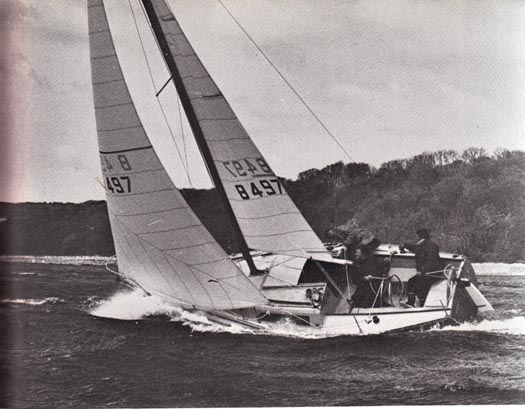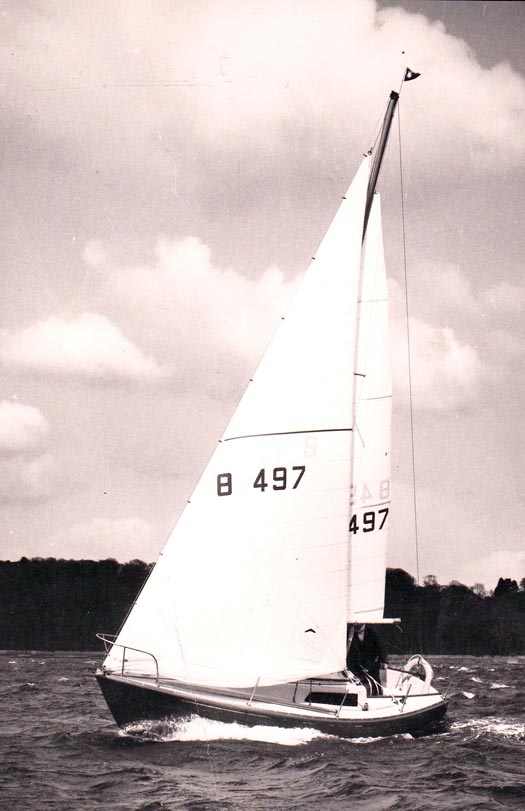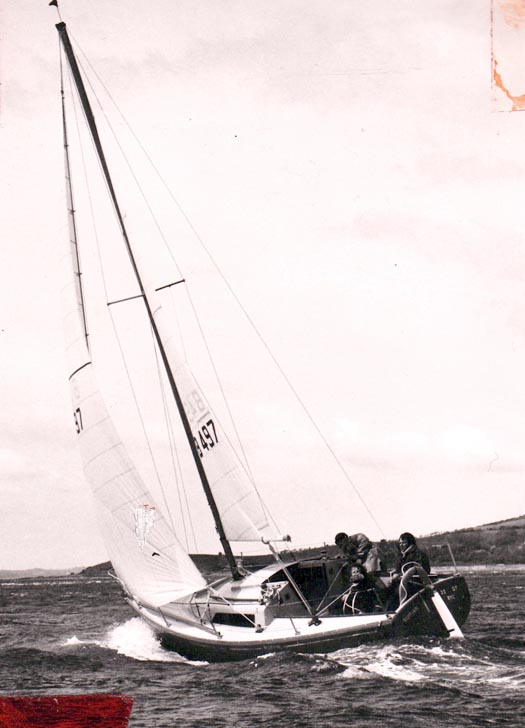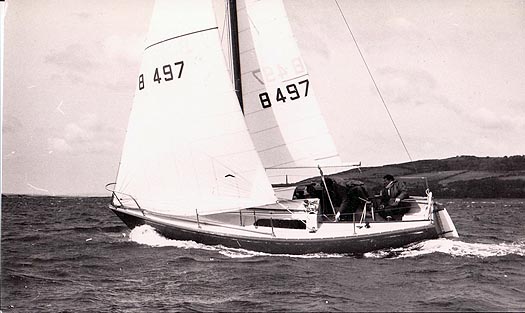#ruffian23 – Congratulations, Ruffian 23s – you've passed your 40th birthday. It was the Springtime of 1973 when we were invited by Dickie Brown to go down to Portaferry for a sail test of the prototype of the new 23ft Quarter Tonner which his brother Billy had designed, working at the drawing board in creative bursts around three o'clock in the morning "when I can think most clearly, as at that time the ether isn't cluttered up with other people's ideas".
The first glimmerings of the idea had probably started back in 1969, when we were all doing the Fastnet Race aboard Ronnie Wayte's Mayro of Skerries. Ronnie had built this 35-footer to designs of his own in fibreglass in his factory in Carrickmacross, where their normal product line was steel domestic oil tanks. Weird enough, you'd think. But I – whose experience of glassfibre boat-building was absolutely zilch - was much involved from the start, simply on the strength of having won overall in the Round Isle of Man Race in 1964 in an old wooden boat.
Things moved slowly down Carrickmacross way, so it was nearly five years after that minor Isle of Man triumph before the new boatbuilding project actually started. But we made it to the Fastnet start of '69, and finished 122nd in a fleet of 250 boats. The smart alecs remarked that it had taken a helluva lot of boats to beat us. But we could point out that we in turn had beaten another 122 boats, and it certainly still stands as the best Fastnet placing ever achieved by an amateur-designed boat built in Carrickmacross.
With Mayro's crew including Dick and Billy Brown, not to mention Barry Bramwell and Dickie Gomes, that race of '69 was a hotbed for notions of future offshore racing projects, and the Brown brothers of Portaferry in County Down on the shores of the Narrows into Strangford Lough were the first to make the notions become reality. Dickie was the sort of can-do man who could turn his hand to anything, particularly if it was to do with working around or building boats, while his older brother Billy was a university lecturer in physics and mathematics who was also a dab hand in creative technical design. Through 1970 they developed the concept of a 34-footer, with Billy drawing the lines and Dickie building the hull of the new boat upside down in three-skin glued timber in a substantial shed conveniently located at the foot of his shoreside garden.
We should all have such a shed. Officially, it was a pig-shed, for in those days you could construct whatever you wished in the way of agricultural buildings in the Northern Ireland countryside. But though at times it did resonate with porcine oinks, in the winter of 1970-71 this was where a rather wonderful offshore racer called Ruffian took shape in a remarkable family project.
Ruffian was a star performer from the start. But after her very successful first season, the Brown brothers realised that if they were to achieve their dream of creating a viable modern boat-building plant in their little home town, a place desperately short of steady employment, then it would have to be with a more manageable smaller boat, around the Quarter Ton size. Thus Weatherly Yachts came into being to build the Ruffian 23, though with the hopes of adding larger sizes in due course.
The prototype of the Ruffian 23 was still being finished by Dickie and his team when I got his phone call, but he reckoned if I could get a crew together and head down to Portaferry, they'd have her ready on the last Saturday of March. It was blowing old boots from the northeast on the day, classic March weather, but conditions were improving as my brother James and I with longtime shipmate Ed Wheeler drove down the winding road south along the Ards Peninsula to Portaferry.
And there she was: Ruffian 23 No 1, just launched and still being rigged. This wouldn't be a test sail. This would be a maiden voyage. But there was now more sunshine between the squalls, and she looked great, a proper miniature offshore racing yacht just asking to be sailed, a big-hearted little boat.
But from the photography point of view, "little" was the operative word. I went off in one of Portaferry's lobster boats pressed into service as a photographer's launch, having told the crew on the Ruffian that not only were they most emphatically not to stand up, but if they were sitting up to weather they'd to crouch down, otherwise the new boat would look tiny and result in photos which would fail to do justice to her gallant spirit.

Squally weather in Strangford Narrows. In order not to exaggerate the Ruffian 23's small size, the crew crouched down as best they could while Dickie Brown remained totally relaxed at the helm. Photo: W M Nixon
This explains why, in the photos - which were taken sailing in the Narrows - Ed Wheeler on the weather rail seems to have been struck down by sudden cramp, while my brother James has succumbed to disablement low down in the cockpit or crouched in the companionway. As for Dickie on the helm, he was Oscar material with his cool performance as a relaxed skipper, sitting conspicuously comfortably despite the fact that every so often ferocious gusts would blast down and do their best to flatten the boat, and spin her too.
In some of the snaps she may look under-canvassed, but we'd plenty of cloth for the day that was in it. As soon as the photos were in the can, Dickie and I swopped places, and he told us to go off up the lough and enjoy ourselves. We did that very thing. Here we were with a completely new little boat which hadn't even been afloat 24 hours earlier, yet we'd an absolute blast up Strangford Lough in the sunshine, and the Ruffian 23 proved herself a gallant boat, a joy to sail with a marvellous beat northward and a tearing run back.

She was a very good looking little boat in 1973 – and she still is. Photo: W M Nixon
This was the fun part, rounded out with the inevitable celebration in Dumigan's. After that there came the work of building the boats, and promoting the design in an era when the oil crisis of 1974 knocked the economy for six. Despite that, top sailors such as former GP 14 World Champion Bill Whisker from Belfast Lough were keen Ruffian 23 racers, while in 1973 Barry Bramwell had taken a souped-up boat to the Quarter Ton Worlds in the south of England, and though the winner was Ron Holland with his larger Eyghthene 24, the Ruffian 23 was in the frame and made a favourable international debut.
Then in 1975 a keen young offshore racing man, Jim Poole from Dublin Bay, kitted up his new Ruffian 23 Ruffino for a proposed three stage Round Ireland Race being promoted by Ballyholme YC, and he placed second overall, his crew being one Eamon Crosbie, who many years later in 2004 was to dominate the Round Ireland Race from Wicklow with his Ker 32 Voodoo Chile.
But back in the 1970s, despite the dire state of the economy the Brown brothers kept gallantly at it, and in 1976 the Ruffian 23 made her official Dun Laoghaire debut, at a Boat Show in the grounds of the Royal Marine Hotel which was visited by President Hillery - a sailing man himself - who spent a long time aboard the boat with Billy Brown.

Dun Laoghaire Boat Show 1976, and President Hillery much enjoyed his visit with Billy Brown aboard the Ruffian 23. Photo: Michael O'Reilly
In all, about 200 Ruffian 23s were to be built, most of them by Weatherly Yachts in Portaferry, then about a dozen either finished or as bare hulls by BJ Marine in Dublin, and then two or three were built by the last owner of the moulds down in Baltimore.
Even allowing for two hundred boats in existence, the spread achieved has been remarkable. Most distant is Hong Kong, whose small but enthusiastic fleet keeps in contact with the two main Irish fleets in Dun Laoghaire and Carrickfergus. These two biggest groups maintain a strongly competitive friendship afloat and ashore, with the Dublin Bay sailors being particularly impressed by the way the Carrickfergus crews sweep them north for the annual entertainment of Burns Night on January 25th. And the most unexpected location is Iceland – two or three boats were sailed up there from Portaferry, underlining the boat's sea keeping and cruising qualities, which are of course the main attraction for Ruffian owners dotted all round the coast nowadays.

Over the years, the Ruffian 23s have proved as able for cruising as they are keen to race. Photo: W M Nixon
This cruising ability has been recognized for a long time. In 1981 Ronan Beirne of Dun Laoghaire won the Irish Cruising Club's Round Ireland Cup with Rila, Ken Ryan's Ruffian 23. Ken being very much involved with international sailing administration both afloat and ashore, he seldom had the time to sail himself. His only stipulaton for Ronan's use was that the boat was to be sailed as often as possible, and cruising round Ireland hit the spot. Equally impressive was a jaunt out to St Kilda in 1983 by three Dun Laoghaire veterans aboard Siamsa. Mickey d'Alton, Leslie Latham and Franz Winkelmann had a combined age of 210, plus Franz was very tall and had to be more or less folded in two in order to get below. But despite all that, they made a fine cruise with their able little 23-footer to Scotland's most remote island.
In complete contrast to cruising was Neville Maguire's out-and-out racing approach. He and Dickie Brown were two of a kind, and when he asked the Portaferry man if he could have the lightest possible Ruffian 23, stripped of non-essentials like the rudder skeg and various comforts, and fitted with a tall and spindly fractional rig which he would assemble from spar parts for other racing boats, Dickie duly obliged. Neville's Spalpeen was the result, a successful little boat, but so spare and sparse that when he moved up to the Club Shamrock Demelza, it felt like he'd moved into superyacht territory.
After forty years, second and third generation Ruffian 23 sailors are making the scene, particularly with the long-established Dun Laoghaire division where the current class captain is Ian Cutliffe. He sails Ruffles, which his father Michael finished back in the day from a bare hull supplied from Portaferry, providing himself with a good-looking boat of character which could look after herself in a blow, and head confidently offshore whether racing or cruising, while also providing good club racing, a boat which punched way above her weight. The Ruffian 23 has stood the test of time in style, nicely in line for her Golden Jubilee in just ten years time.































































